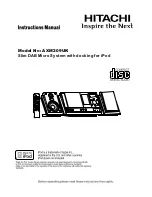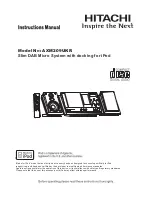
LX8 & LX12
OWNER’S MANUAL
19
GLOSSARY OF TERMS
BALANCED
A 3-conductor (including shield), low-impedance connection. Balanced
cables are the preferred method for hum-free interconnection of a
sound system for their noise-rejection characteristics.
(Also see Unbalanced.)
BUSS
An output destination in a mixer. For example, the left and right main
outputs are called busses, because you can send a channel to one or
both of them. Also spelled Bus
CHANNEL
One of any number of signal paths in an audio circuit, such as input
channel, output channel, recording channel, left channel, right
channel, etc.
COMPRESSOR
A device that reduces the dynamic range of the audio signal passing
through it. When compressing a signal, the louder parts of the signal
become quieter, and when make-up gain is applied, the quieter,
subtler parts of the signal become more pronounced. This often
produces a more articulate and polished sounding signal that can
stand out better in a mix.
DECIBEL (DB)
A term representing the ratio between different audio levels. It can
either refer to the electrical signal running through a channel or the
acoustic sound level coming from a sound source.
EQUALIZATION
Electronic filters that adjust the level of certain frequencies. Used for
tone enhancement or to reduce extraneous sounds. Two types of EQ
shapes are Peak and Shelving, described below.
HI-Z (HIGH IMPEDANCE)
In the audio equipment realm, the term “Hi-Z” or “High-Impedance”
generally refers to inputs designed for passive guitar or bass signals
(1MΩ or thereabouts).
HPF (HIGH-PASS FILTER)
An electronic filter that passes signals with a frequency higher than
a specific cutoff frequency and attenuates signals with frequencies
lower than the cutoff frequency.
IMPEDANCE
Resistance in an electrical circuit measured in Ohms (Ω). Maintaining
proper impedance (between amplifier and speakers for example) is
important to prevent damage to the amp.
48V PHANTOM POWER
A voltage signal that runs through a microphone cable to power
condenser microphones. Harmless to microphones that don’t need it,
except for very old and/or damaged ribbon microphones.
SHELVING EQUALIZER CONTROL
Increase or decrease of all frequencies above or below a specific point.
(Compare to Peak Equalizer Control; see pages 8-9 for more information.)
TRS
Acronym for Tip-Ring-Sleeve — the three parts of a three-
conductor (including shield) audio plug. TRS phone plugs are often
used for “balanced” mono connections, or stereo “unbalanced”
(head-phone) connections.
TS
Acronym for Tip-Sleeve, the two parts of an unbalanced, two-
conductor (including shield) phone plug. TS connectors are some-
times called mono or unbalanced plugs or jacks.
UNBALANCED
A two-conductor (including shield), high-impedance connection.
These are most commonly used for instrument connections and cable
runs of less than 20 feet.
XLR
The three-pin connector universally used for balanced audio
connections. A balanced connection reduces outside noise
and interference.
(See Balanced above.)
Содержание LVL Series
Страница 1: ...LX8 LX12 OWNER S MANUAL LX12 LX8 ...
Страница 17: ...LX8 LX12 OWNER S MANUAL 17 LX8 BLOCK DIAGRAM ...
Страница 18: ...LX8 LX12 OWNER S MANUAL 18 LX12 BLOCK DIAGRAM ...
Страница 23: ......





































